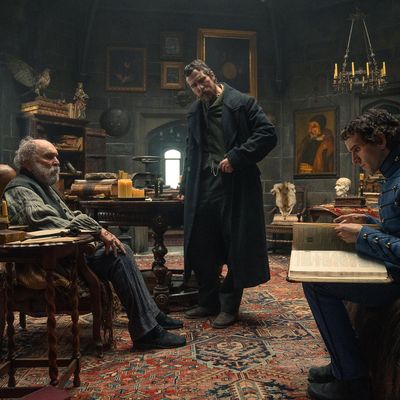
The barren trees and snowy ridges of the Hudson Valley in winter have rarely looked as forbidding as they do in Scott Cooper’s The Pale Blue Eye, a mystery that’s more about mood than ingenuity. But the chill you feel in your bones may actually enhance the suspense; Cooper clearly understands that mysteries live or die on their atmosphere. Those of us for whom Sherlock Holmes served as a gateway drug into serious literature can testify to this: The Victoriana, the cobblestones and gaslight, all were just as essential as the cases themselves to our fascination, maybe more so. And now, here’s an appropriately thick, foggy counterpart to those stories, set at West Point in the 1830s, that holds its own.
Based on Louis Bayard’s 2003 novel, The Pale Blue Eye follows a veteran New York detective, Augustus Landor (Christian Bale), living by himself in the woods, who is pulled out of retirement to investigate the grisly death of a cadet at the United States Military Academy. Leroy Fry (Matt Helm) has been found hanged with his heart cut out, and nobody can decide if it’s a suicide or murder or why it happened. The grizzled, grimacing Landor has an unspoken confrontational relationship with the school — he shows total disdain toward everyone around him — but accepts the case anyway. He then enlists as his aide an awkward young cadet, Edgar Allan Poe (Harry Melling), who tells him early on that the murderer they seek must be a poet. “The heart is a symbol, or it is nothing,” Poe explains. “To remove a man’s heart is to traffic in symbol. And who better equipped for such labor than a poet?”
Deep, man. Poe fascinates Landor, who starts to look at this young odd fellow with fondness. Bale has been so good for so long at playing standoffish characters that it’s bracing to see warmth toward somebody else descend upon his gaze. Landor has lost his wife to illness, and his daughter, we’re told, recently ran away from home; he came to these woods to find happiness with his family and wound up alone and embittered. When Poe visits Landor’s house and admires books that were clearly his daughter’s, we start to understand why the older man has softened around this misfit poet-cadet: The young man reminds him of his lost daughter. And Poe, who says he sometimes speaks to his dead mother, could use some paternal grounding.
This father-son dynamic powers the whole picture and sets up several key moments in the film’s climax. That, in turn, asks a lot of Melling, and you never quite know where he’s going with his wonderful Poe. Cavernous eyes dominating a face that’s otherwise all cheekbone and chin, he brings to this outsider a fey, haunted confidence. He alternates between swells of sadness and grandiosity, the mark of an honest-to-goodness Romantic. You feel the tragedy of his winding up at a place like West Point. (In real life, Poe lasted only a few months at the school.) You also sense, in his mannerisms and speech, that this is a man who will either make his mark on the world or end up dead in a ditch. (As it turned out, both sort of happened.)
On a purely narrative level, The Pale Blue Eye offers relatively standard developments: a hidden note here, an unnoticed wound there, an encrypted diary there. We’re dealing with a fundamentally cozy genre, however, and familiarity is allowed and encouraged. Plus Cooper understands that clichés handled with confidence can be effective. (This is, after all, the man who made Crazy Heart.) So he leans into them. A doomed character doesn’t just cough early on — they have a full-on seizure. Exposition is delivered with actorly aplomb. It helps that the supporting cast is comically stacked with performers who have carried entire movies: Timothy Spall plays the head of West Point; Toby Jones plays the school doctor; Gillian Anderson (!) plays the doctor’s emotionally fragile wife; Charlotte Gainsbourg (!!) plays a barmaid. Robert Duvall (!!!) plays a professor of the occult. (Is he the only American in the cast? Possibly.) There is at least one major miscasting among the younger actors, but to say more would constitute a spoiler.
Ultimately, it’s all pretty gripping, not just because of Bale and Melling and the heady atmosphere but because the crimes being investigated are savage on a downright existential level. The murders are monstrous enough to capture the imagination, and Cooper makes sure to prod us along by dwelling on the pasty, swollen corpses; the grotesque, coagulated wounds; the fingers stiff with rigor mortis being cracked on autopsy tables.
This also sets up a challenge for the movie: how to deliver a solution that not only makes sense but also honors the captivating cruelty of the crimes committed. And amazingly, the film’s finale is a genuine hoot — totally unexpected yet expertly sold through the clever deployment of information. Unlike a lot of mysteries that are designed to be unsolvable by an audience (which is a valid approach; remember, Arthur Conan Doyle never gave us all the necessary clues, either), The Pale Blue Eye shows us everything we need to figure it all out and still manages to pull the rug out from under us. Even so, what ultimately resonates are the picture’s surprisingly moving central relationship and its vivid setting.
More Movie Reviews
- The Accountant 2 Can Not Be Taken Seriously
- Another Simple Favor Is So Fun, Until It Gets So Dumb
- Errol Morris Has Been Sucked Into the Gaping Maw of True Crime


